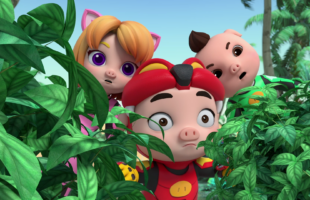Most of the drama on Australian television this year has been going on in the boardrooms rather than on the screen, but should they ever decide to turn it into a TV show it would likely make a riveting plot.
In the past 12 months there have been takeovers, poaching, court dramas, proposed mergers, unwanted attention from the Australian regulator – the Australian Competition and Consumer Commission (ACCC) – and yet another blow for a beleaguered Rupert Murdoch.
Network outage
Ten has been network most in the spotlight of late. Previously owned by Canadian media organization CanWest, late last year, media heirs Lachlan Murdoch and James Packer joined forces to launch a share raid on the network. Packer started the ball rolling by taking an 18 per cent stake in Ten but later sold half of it to Murdoch.
The pair did not rest on their laurels and within a couple of months both had seats on the Ten board. Previously a youth-skewed, low-cost affair, Ten decided to put a lot of money into news and current affairs in 2011 as well as sport for its additional digital channel One. Both Packer and Murdoch thought this strategy was a mistake and were keen to return it to its low-cost roots to take advantage of the rise in TV ad spending.
After unceremoniously dumping Ten’s chief executive offi cer Grant Blackley in February, team Packer- Murdoch launched a review of the network’s operations. The results of the review were published in August and Murdoch said Ten would spend an additional A$39 million in restructuring, which will see an estimated 170 redundancies at the station.
Lachlan Murdoch, who is currently acting CEO of Ten, said the “rigorous restructuring” would put all the money saved into “new programme initiatives” designed to lift ratings and help it battle the dominant Seven and second-ranked Nine networks.
Murdoch senior has also come against hurdles in his bid to take over Australia’s overseas TV service, The Australian Network, which reaches 44 countries in Asia and the Pacifi c – the Aussie version of BBC Worldwide.
The A$223 million tender has only two bidders, the public broadcaster the Australian Broadcasting Corporation (ABC), whose contract to operate the network was set to expire in August, and Sky News Australia, which is part-owned by Murdoch, Seven and Nine.
Sky News Australia pressured the government to put the service out to tender last year and the process closed in February; a winner was to be announced in May. But on June 25, it was announced the tender process would be extended and the government has now requested more information from both parties.
Responsibility for the fi nal approval has also moved from the Department of Foreign Affairs to the Minister for Communications Stephen Conroy, who oversees the governmentfunded ABC.
A spokesman for the minister said that the changes were made to help evaluate “the tenderers’ ability to support Australia’s national interests.” He added that part of this national interest clause would be factoring in the effects of political uprising in the Middle East as well as “key emerging markets.” Normally government-speak for China – which the network currently has not been able to get a foothold in.
Close for comfort
Sky News Australia is not the only payTV player in the news this year with the announcement in May that dominant player Foxtel had reached terms on a friendly merger with its regional provider and partner Austar.
Telco Telstra owns 50 per cent of Foxtel, while Rupert Murdoch’s News Corp., and James Packer and Kerry Stoke’s Consolidated Media each have 25 per cent.
The pair agreed on a price worth more than A$2 billion and it took several months to get the kinks worked out, but rumours of the merger had been around for a much longer time. The deal is expected to give the two companies better synergies and stronger subscriber growth. It also means that the two payTV businesses can turn their focus to battling the free-to-air channels, and their recently added suite of digital channels.
“A merged Foxtel and Austar would make compelling strategic sense, and it would continue to invest and innovate in a superb digital service for consumers across Australia, including investing heavily in marvellous new original Australian content,” Foxtel’s chief, Kim Williams, said at the time of the announcement. But sadly not everyone agreed.
The merger hit a snag in July with the ACCC. The watch dog warned that the deal would affect competition in three areas: national payTV provision, content acquisition and telecommunications provision in some areas. It seemed an unusual call since the two companies currently divide the payTV market up amicably between regional and city territories but the ACCC believes the rollout of the Australian National Broadband Network (NBN) would allow Austar to provide its services in cities without the barrier of cables or dishes and could position itself in time as an effective competitor to its partner, helping to drive payTV subscription prices down.
In its statement the ACCC said: ‘’Foxtel and Austar are the only signifi cant providers of subscription television services in Australia. The proposed merger would therefore effectively create a near monopoly subscription television provider across Australia.’’
One new player is IPTV service Fetch TV, which is aiming to shake up the Australian TV market by providing not only competition to the current free-to-air and payTV veterans but change how customers view TV by allowing them to watch web videos on television, provide access to the ABC’s popular catch-up service iView and make itself available on various handheld devices. Fetch TV has limited penetration at present available only through internet service providers (ISP) such as iinet, but it plans to spread to the majority of ISPs in the coming year.
Still it is unlikely to partner up with Australia’s biggest telco Telstra as it is pushing its own online TV service T-Box and also has a slice of Foxtel, which content it needs to keep profi table.
The leader in the online TV fi eld remains ABC’s iView, which regularly posts programmes that can draw audiences of up to 300,000 but one problem with these delivery systems is they do not encourage viewers through the provision of new, webspecifi c content. Instead, they rely on repeats of the main channels shows and the screening of older popular content such as Get Smart, Fawlty Towers and a range of US sitcoms.
Foreign nationals
A report by Screen Australia in August found that, far from aiding content makers, the new media landscape is diluting Aussie content on the small screen with a 154 per cent hike in foreign content in the past three years. The report, Convergence 2011: Australian Content State of Play, is part of the funding organisation’s submission to government which is undertaking a review on the subject.
“Audiences are fragmenting away from the main FTA channels to multi-channels that have no Australian content requirements and this has resulted in a signifi cant decline in the diet of Australian content,” said Screen Australia’s chief operating offi cer, Fiona Cameron.
The report also found that while the audience had increased for children’s content, via dedicated digital channels like ABC3, production of kids TV had not increased above the level legally required by the government. So while viewership is up, the highest audiences for children are occurring during the early evenings, for G-rated content such as MasterChef, Australia’s Got Talent and Dancing with the Stars; as well as PGrated content such as The Big Bang Theory and How I Met Your Mother.
The report surmised that should government quotas be relaxed kids programming would be in trouble.
Meanwhile, Nine Network is rumoured to be limbering up for a share listing. Nine’s private equity owner CVC Asia Pacifi c has been streamlining the business with many speculating it will head to the sharemarket to try to recoup some of its losses from buying the business just before the global fi nancial crisis.
Over at Seven Group Holdings, owner of top-rating free-to-air Seven Network, recently merged with West Australian Newspapers in what was effectively a takeover by WAN of the TV group, creating Australia’s biggest diversifi ed media business. The A$4.1 billion entity marks further consolidation of the Aussie media sector. The group combines WAN’s newspaper interests with Seven Group’s TV stations and magazine interests just a year after Seven Network merged with heavy machinery group WesTrac to create Seven Group Holdings. It also comes after the expansion of the Seven Network in a joint venture with private equity fi rm KKR in 2006. “The media landscape is evolving rapidly,” said Seven’s Kerry Stokes, who is also chairman of WAN.
In fact, Stokes is the one feature that binds all the companies, which ordinarily would have nothing in common. The billionaire media mogul had trouble explaining the very few obvious synergies for the merged entity but that did not stop shareholders agreeing to the merger. In fact the one thing the deal does do is keep Stokes very much in the driver’s seat of the new entity.
Spoons and shovels
Amid all the off-screen dramas there has been the usual ratings winners and losers. Ten has managed to keep its delicious reality vehicle MasterChef Australia simmering along nicely with audience fi gures consistently crossing the 1 million mark and with an audience of 2.3 million watching the season 3 fi nale last month. However Ten has had little luck in making the same headway with its new reality vehicle The Renovators, which effectively applies the MasterChef competition template to the arena of home renovations. Produced by Shine Australia, the same production company as MasterChef the new format has struggled in the ratings with audience fi gures levelling off around the 700,000 mark despite a big push from Ten. In a bid to attract more eyeballs to the show, the network made the controversial move of splitting the MasterChef fi nale in half and sandwiching The Renovators in the middle. The move understandably backfi red with huge public ire, particularly with younger kids who were forced to go to bed without seeing the end, in a format Ten labels “a family show”.
Despite its lacklustre ratings, Ten has confi rmed that The Renovators will not be downing their tools and will be included in next year’s schedule.
Makeovers seem to work at Nine however. The network had a surprise hit with the second season of its own renovation competition series The Block. Originally failing to leap out of the start gate when it fi rst bowed back in 2003, it is now attracting a regular audience of 1.5 million.
Drama though, has not fared as well this year. Nine Network’s continuing crime series Underbelly: Razor, set in the sly grog trade of the 1920s, was an obvious stand out with a debut fi gure of a whopping 2.5 million, but the high ratings tapered off quickly to 1.7 million by the second episode. Meanwhile Seven Network’s perennially successful series Packed to the Rafters returned in February with a huge 1.9 million viewers, but in March went on hiatus and was replaced by new drama series Winners & Losers. Packed fi nally headed back to screens in late August.
With the year coming to a close it appears that Seven Network will once again take out the ratings crown, but a resurgent Nine has had a good year. Ten meanwhile while will sit in its usual third place in the food chain. That said, with the amount of wheeling and dealing at a corporate level, come next year there will be few things that the Australian television industry will be able to take for granted.







